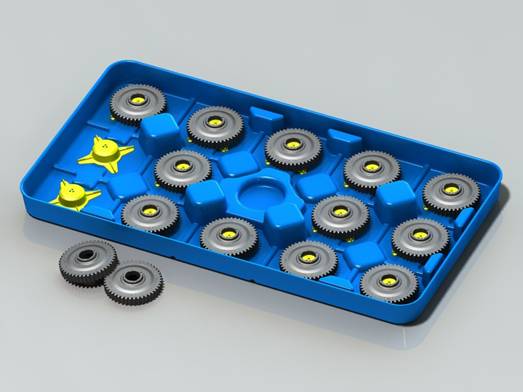Two processes, two materials…and the collaborative resources of two thermoplastic forming firms combine to formulate one new dunnage concept protecting parts, budgets and productivity.
During the past few decades, the development and proliferation of plastic formulas for tough, high strength urethanes, polymers, polyethylene and elastomers have revolutionized everyday products. Also affected are the packaging those products come in, and even the devices used to handle, convey and transport those products during their manufacture. Today, manufacturers are relying more and more on tote boxes, platforms, trays, racking and palletized containers made from plastics and their numerous derivatives to safeguard parts during handling and shipping functions.
These new plastic devices are typically reusable yet, unlike metal containers, usually offer lower initial costs, shorter lead times, are lighter in weight and require less maintenance costs. Compared to consumable containers such as cardboard, plastic units eliminate long-term repetitive investments, breakdown and disposal costs. They are also impervious to cutting fluids and lubricants, and are better able to protect parts from collisions. And, within the alternatives, plastic containers provide economical opportunities to modify designs to meet a specific application challenge.
Merely substituting a plastic container for metal or cardboard would make the job simple, according to Greg Hancock, vice-president and general manager of ThermoFlex LLC, Morrison, TN-based thermoforming specialists. But, in most cases, it’s not that easy.
“The number of plastic material options, the different manufacturing processes, and the applications themselves,” says Hancock, “present myriad design, engineering and process challenges that require unique and innovative solutions. Load capacities, strengths, stacking capability, handling options, environmental hazards, economics and ergonomics, as well as part configuration and protection are integral elements of the tool design, the material and the process selection. Those are the elements we’ve recently incorporated into a new pallet tray concept designed to protect heavy metal components.”
In particular, one application Mr. Hancock refers to was for an automotive supplier who finishes gears and other drive train components. The supplier had already switched to vacuum formed trays made from high density polyethylene (HDPE) for handling in-process gears. However, there was a problem with the sharp edges of the parts in that, when placed in the trays, the pieces were gouging the relatively soft tray surface and creating plastic shavings that could contaminate the parts. This problem was compounded by the fact that the vacuum forming process does not typically hold tight tolerances, thus parts could move substantially and make further contact with the surface and create additional slivers.
That’s when ThermoFlex engineers proposed a dual faceted solution, combining the economy and size capabilities of the vacuum forming process to produce trays with the durability and accuracy of molded thermoplastic urethane (TPU) inserts as nests for the parts. The trays are formed to 1/4″ material thickness, measure approximately 45″ x 48″ x 3″ high and are designed to hold just one layer of gears—stowing 36 parts in total.
The trays utilize a 180o stack and nest design that allows the trays to be securely stacked when filled with parts, then by reorienting the trays 180o to each other, provides partial nesting to save space for storing and transporting empty containers.
One unique feature of ThermoFlex’s new system is working with its sister company, PolyFlex Products (Livonia, MI), manufacturers of thermoplastic injection, low-pressure foam urethane, cast solid elastomers and thermoset components, to create a synergistic approach in developing a single-resource, turnkey solution. Another feature is using the TPU material and the injection molding process to fabricate the inserts, establishing the surface toughness and resilience required to withstand multiple contacts with sharp edges, and producing ‘nests’ of tighter size tolerances that restrict movement of the parts. The inserts are formed to a 1/2″ thickness, providing a strong and stable stowage space.
The molded inserts are attached to the bottom of the tray by way of an expanding plug or anchor attached to the insert. The bottom of each tray is drilled with 36 holes through which the plug end of an insert is pushed…once through, the anchor expands to prevent its withdrawal and to hold it snugly to the tray. The interior bottom of the tray also features a formed projection that each insert fits over to aid in its positioning.
According to Mr. Hancock, the two-material, two-process tray and dunnage units are proving to be a success in many applications in addition to the gear manufacturing project. “The largest parts of these handling systems, the tray,” he explains, “are made from HDPE, which is about 1/3 the cost of TPU, just in material. As a result, we’ve been able to keep the costs contained while improving the performance of these containers, the quality of the output, and the productivity of the operations. Working with PolyFlex, with their range of options and resources, allows us to deliver optimum solutions instead of promoting just one process or one material.”
ThermoFlex processing capabilities include thermoset cast urethane molding and thermofoam operations in addition to its thermo/vacuum forming capacities to 5′ x 9′ x 25″ deep. Products include urethane coated conveyor rollers, as well as tool protection holders for the metalworking machine industry, assembly tools, bumpers, enclosures, grippers, covers, wipers, seals and custom dunnage components including custom design and prototyping services.
Dual-construction gear handling pallet trays—using HDPE material and the vacuum forming process for the tray with injection molded TPU for the inserts are helping to protect parts, eliminate plastic ‘sliver’ contamination and minimizing costs.

